

Originally posted April 1, 2020
Today in Gun of the Week, we'll be taking a look at one of the most iconic, yet paradoxically least-well-understood, infantry weapons of the Early Contact Period. This is, to give it its full name, a Wedge Defense Force Projector, Infantry, Wave-Force Conversion Beam, Anti-Kaijū, Number One Mark Two-Star, commonly known as a Type II Wave Motion Rifle.
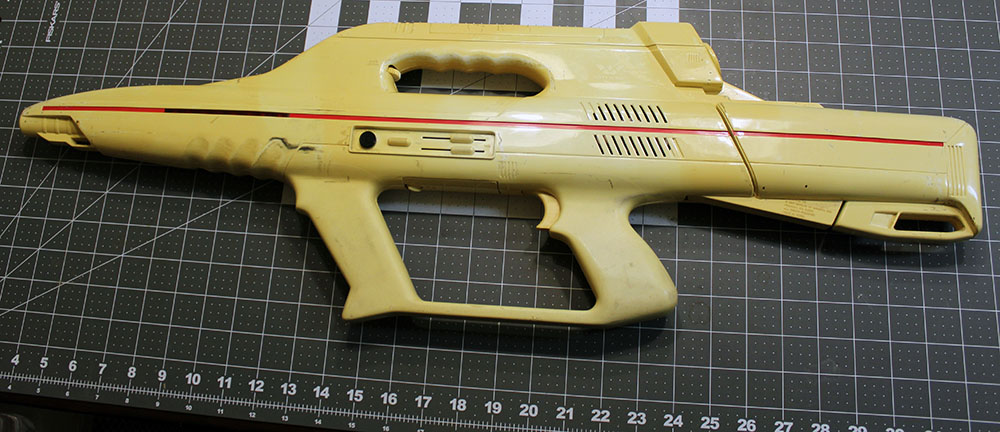
There is a persistent legend among Wedge Defense Force and World Welfare Work Association members that the roots of this weapon actually reach back to before the formal founding of the WDF, to the myth-shrouded and mysterious incident that spurred the pioneer members of those organizations to flee Earth. This legend has it that the original Wave Motion Rifle was created at WPI in the fall or early winter of 1991 by none other than founding 3WA TroCon and galactically notorious weapons designer Kei J. Morgan.
Accounts vary as to exactly how Morgan accomplished this feat before the discovery of Overtechnology. Some versions of the story attribute her success to the same probably-apocryphal "virtual realization" technology that supposedly powered Robert "ReRob" Mandeville's prototype Cyclones. Others say she built it in the school's electrical engineering lab using equipment originally intended for high-energy physics experiments. Still another version has her building the device in a cave (precisely where there was a cave in pre-Contact Worcester is not elaborated upon) with a box of scraps.
Regardless, the original WMR was allegedly used during the Second Battle of WPI (January 1, 1992) to destroy the GENOM command and control center at Alden Hall. It then disappears from history—if it can ever truly be said to have been there, since its actual existence, like so many of the controversial details of the First Wedge War, cannot be proven. Whatever the truth, no such weapon was seen again for nearly a century.
In 2088, the city of Mega Tokyo on New Japan came under attack by giant monsters (immediately dubbed kaijū by the local authorities), a development for which the city's civil defense force was, perhaps understandably, somewhat unprepared. The colony's government called upon the WDF for help, which, at least at first, the Force was not entirely sure how to provide either. Assaulting building-sized monsters was not part of the standard operational procedures at that time. Attempts to engage the creatures with Destroids, air strikes, and other such large-scale interventions met with limited success.
More promising was the deployment of small infantry teams armed with Thunderbolt® 12-gauge photon torpedoes. These units could outmaneuver the kaijū on the ground, performing hit-and-run strikes with their heavy but accurate weapons, and eventually inflict enough damage to bring the beasts down without leveling entire sections of the city—but it was a drawn-out, difficult, dangerous process, and still caused considerable collateral damage.
Enter Kei Morgan, who, working alone and in secret, developed a one-person anti-kaijū beam weapon in about six weeks. The Type II Wave Motion Rifle's devastating firepower, extreme portability, and pinpoint accuracy enabled small squads (or very bold single operators) to slay kaijū much more quickly than the Thunderbolt teams, and with (usually) even less incidental damage to the surrounding cityscape. Six weeks after the first WMR-equipped WDF troopers and TroCon teams hit the streets, the kaijū attacks ceased, as if some higher authority had seen how outmatched the monsters had become and called off the offensive.
Wave Motion Rifles remained in the WDF and 3WA arsenals until the WDF's fall in 2288, when most were presumably lost in the destruction of the SDF-17. Four were known to remain in the 3WA's inventory, maintained against future contingencies, but their deployment was never authorized after 2288.
With the historical background out of the way, let's take a closer look at the specimen we have today.

This happens to be Morgan's original prototype, but all of the Type II WMRs were made to the same specification, so its place in the production order makes little difference to its capabilities or manual of arms. We can tell it's the prototype partly by its color. Like all the subsequent production models, the WMR-II prototype was originally white, but its duraplast shell contained a formulation error that caused it to turn yellow when exposed to the backflash from its beam the first time it was test fired. This flaw was corrected before any more units were produced. (Production units were also white, although there are rumors that a single black example was made for the WDF's covert Special Æther Service Regiment.)
We can get a sense of the rifle's original color by taking a closer look at the retractable shoulder stock:
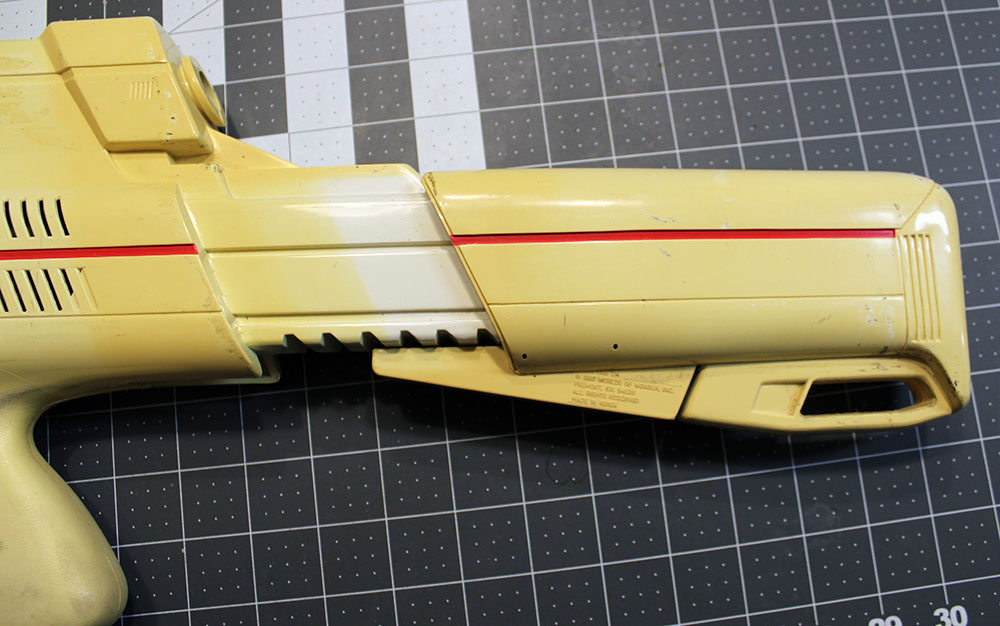
As you can see, the stock on this particular unit was in the third of the six available positions for the initial test firing, so that the rear part of the extension span was not exposed, and the duraplast there has retained its original color.
You may also notice the embossed marking on the stock adjustment lever, which seems slightly incongruous for a weapon manufactured on New Japan in 2088. It claims that the rifle was made in the 1980s on Earth, for a corporation called World of Wonder, Inc. More incongruous still, a little research turns up that World of Wonder was a toy company—a point reinforced by the logo up on the left-hand side of the rifle's upper casing.
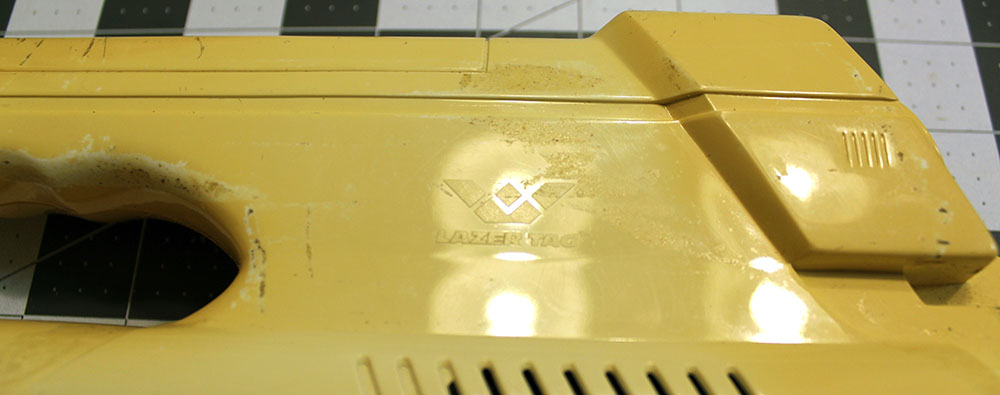
These markings reveal the strange combination of improvisation, ingenuity, and sheer, unadulterated kitbashing that went into the creation of the WMR-II. Faced with a need to produce a working weapon as quickly as possible, TroCon Morgan enclosed the inner workings of her prototype in a duraplast shell cast from the outer casing of a twentieth-century battle simulation toy from her extensive collection thereof: in this case, a "Starlyte Pro" infrared beam rifle, which was the flagship toy in a line of battle simulation toys sold on Earth in the 1980s under the brand name Lazer Tag.
Either because she was in such a hurry, or because it simply amused her to leave them, she didn't even bother removing the toy's trademarks from the mold. They remained in place throughout the susequent production run, leaving all examples of the galaxy's most powerful hand-held weapon to bear the name and manufacturer information of a long-extinct twentieth-century toy.
Make no mistake, however: Despite this curious quirk of its construction, the Type II Wave Motion Rifle is no toy. In the right hands, it can destroy virtually anything up to a Victory-class GENOM Star Destroyer.
Let's have a closer look at the weapon's primary controls, which are all grouped in a convenient panel on the left side.
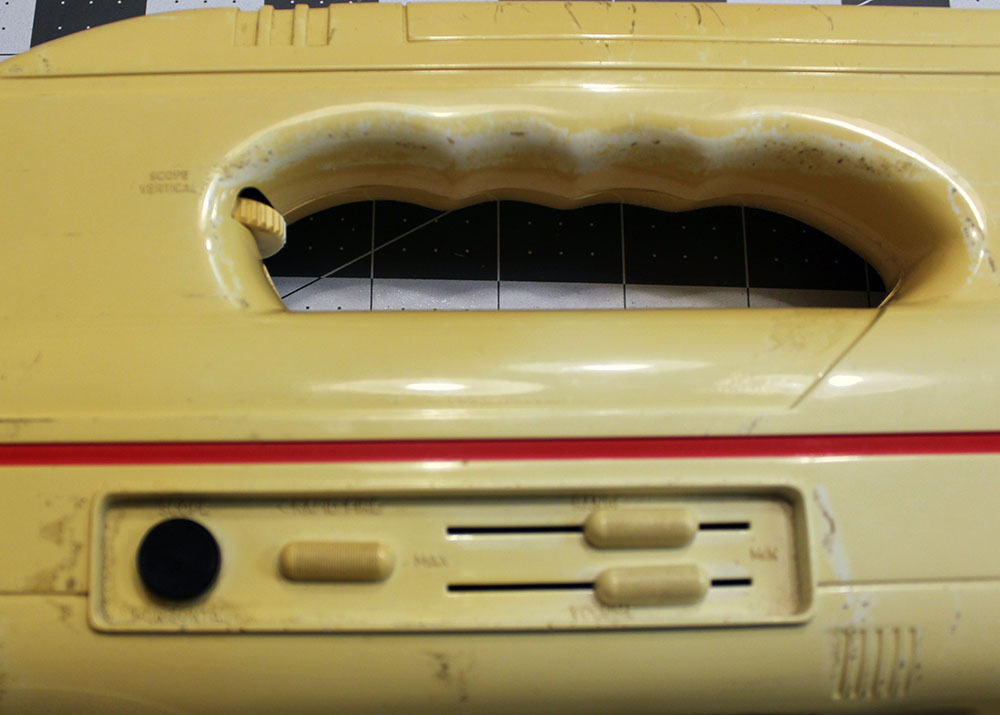
The wheel up in the front of the carry handle is the magnification adjustment for the rifle's integrated optical sight, which is built into the top span of the handle. This is an illuminated-reticle, radar-assisted precision sight with variable 1×–6× magnification. (The embossed SCOPE VERTICAL marking denotes that in the original toy, the wheel controlled the sight's elevation adjustment, which is controlled automatically by the radar assist in the WMR.)
The black circle at the left side of the primary control panel was the windage adjustment for the sight on the original toy, but on the WMR it is in fact a push button, which is used to power the weapon on or off. It must be pressed quite firmly, reducing the chance of accidentally activating or deactivating the rifle.
Next back is a two-position switch which selects between the rifle's two fire modes. Setting this switch to the right (i.e., rearward) is the fine-adjustable semiautomatic mode, which makes use of the two sliders to the switch's right. The lower slider controls the beam's power level; all the way to the right applies about as much energy to the target as an Auricon PP-AR1 phased plasma assault rifle, while all the way to the left delivers the full Class Omega payload. The upper slider is for adjusting the rifle's beam attenuators, which change the focal point of the positron colliders and therefore the maximum range (useful in a weapon that can cause such devastating collateral damage with a missed shot).
These two settings interact, because the rifle's maximum range is affected by both the attenuator setting and the power level. At minimum power and maximum attenuation, the beam only travels about 100 yards before dissipating; at full power and with no attenuation, maximum range is uncertain, but presumably measured in tens of thousands of miles.
The positions of these two controls shown in the photograph are the customary settings for using the rifle in a regular infantry combat scenario, i.e., not engaging an armored or kaijū-scale target. They make the beam roughly as powerful as a Starfleet Type VI phaser rifle, with a maximum range of approximately 500 yards. They are also the positions to which both sliders are automatically set and locked when the two-position switch is set to the left (forward) setting, which engages what the manual calls "pulse fire" mode. This mode simulates the fully automatic fire mode of conventional firearms, replacing the continuous beam with a stream of 0.25-second pulses, sustained for as long as the trigger is held down. Limiting the range and power settings in this mode prevents overheat and restricts energy consumption to a rate that allows for five minutes of continuous fire (1,200 pulses) before the rifle must be reloaded. The need for this is signaled by a message that appears in the optic, as well as this indicator lamp on the side of the rifle:
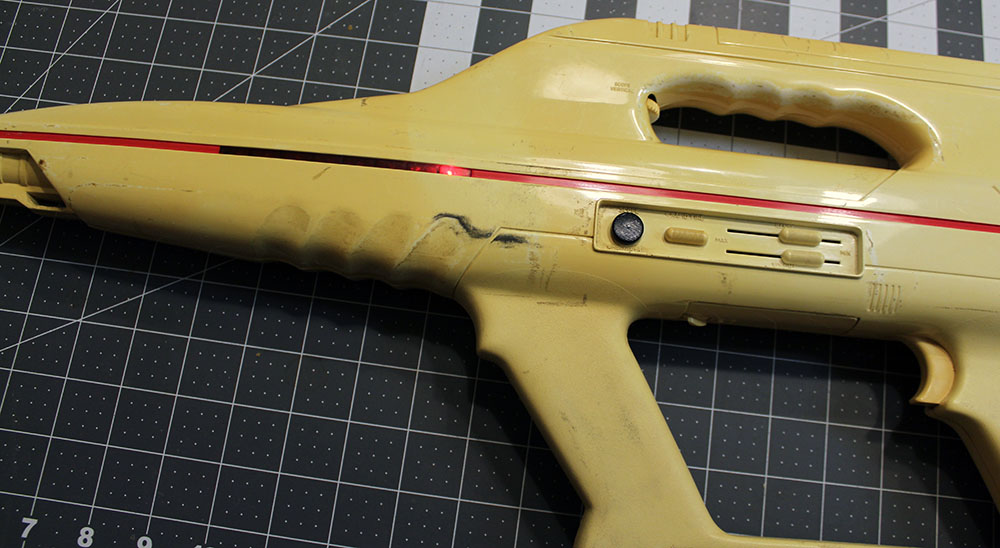
That light, and a matching one on the other side, comes on when there are five seconds' (automatic mode) worth of fuel remaining, although it can be overridden in the unlikely event that the rifle's operator is trying to be stealthy.
The high capacity is a necessary provision, since, unlike most conventional projectile and energy-based infantry weapons, reloading a Type II Wave Motion Rifle is not a task to be carried out under fire. The ammunition system (which, as we will see, is technically a fuel system) is the main shortcoming of the rifle's design from the standpoint of a combat weapon.
Type II WMRs are powered by Class C HBT cartridges, which were the standard fuel modules used by a number of other WDF weapons of the era (most notably the EP-37 and EP-40 particle beam weapons fitted to VR-052 Battler Cyclone variants). Thanks to the fact that the WMR-II had been hurriedly based on the shell of a 20th-century toy, however, removing and replacing those cartridges was a much less quick and simple procedure than in those purpose-designed weapons.
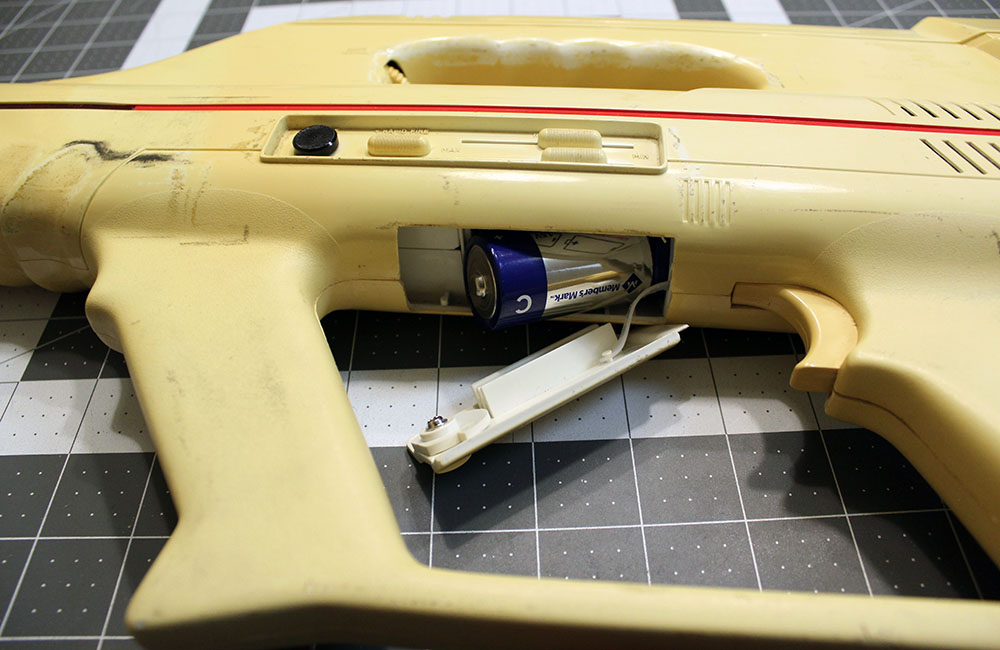
Instead of simply ejecting a spent HBT cart and slotting in a new one, the WMR operator must open what used to be the battery compartment of the Starlyte Pro, pry out four empties, and install four fresh replacements in the prescribed manner, then close the compartment again. The cells fit tightly, and can take a bit of fiddling to arrange properly, particularly the ones that must be inserted into the fueling port and then slid back into the compartment (which is larger than the door leading into it, accommodating the cartridges in two rows of two). With practice, this procedure can be accomplished in a minute or two, but compared with the mere moments it takes to reload any other issued beam weapon, this is an eternity. Fortunately, the weapon's high capacity makes it possible, with care and planning, to conduct most operations without needing to do so during an engagement.
Mind you, that's not really why that capacity is there. It's there because, when employed in its primary role, the rifle needs all of it. A freshly refueled Type II WMR can sustain a full-power beam for three seconds before its HBT supply runs dry. Of course, whatever it was fired at for those three seconds won't be there any more at the end, but still. These things can throw a lot of energy in a very short amount of time.
Exactly how it does that is still unknown to more than a handful of armorers and heavy weapons specialists around the galaxy. All the rest of us know is that its core function works by the same principal as the Wave Motion Engines that power certain classes of heavy combat starships—and how many people understand how those work, either?
Regardless, the Wave Motion Rifle was never intended to be field-serviceable; like the toy it was based on, the outer casing is sealed, and only meant to be opened under controlled conditions by trained professionals. There are rumors that cracking one open without proper facilities and preparation will unleash the Cosmic Forces lurking within and give everyone a real bad day. It's possible that this is an urban legend, perhaps perpetrated by the weapon's actual makers to discourage amateurs from messing around with the guts of the thing—but why take the chance? We won't be attempting to dismantle this one today.
Before we go, though, let's have a look at the sighting system. As noted earlier, the Type II WMR has an optical sight. This is the only sight the weapon has; there are no backup conventional sights. If the optic or its active sensor package fail, the tube can still be used as a rudimentary emergency sight as long as it isn't occluded, but the customary secondary aiming method is to switch to rapid fire mode and aim with the fire stream, then go to full-power mode for the kill.
Getting a picture of the WMR scope's reticle is very tricky with one hand holding up the rifle and one on the camera, but you can get a sense of it from this:
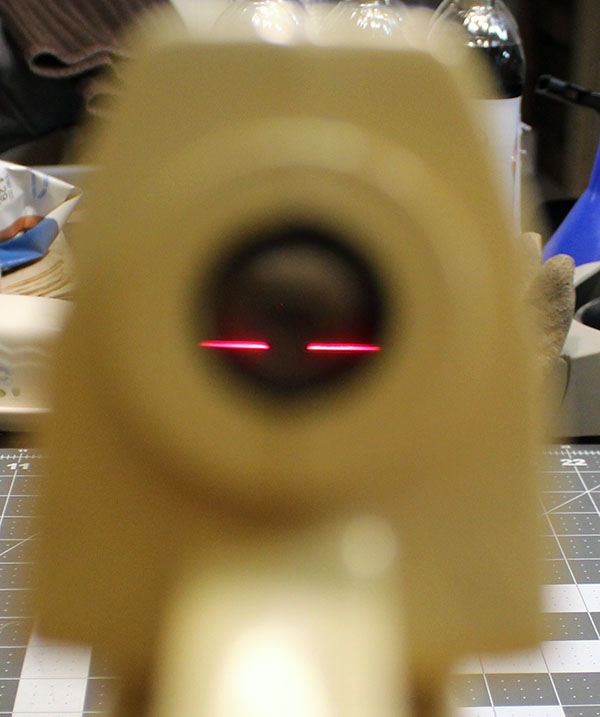
The red lines are the converging azimuth indicators for the radar scope, which illuminate when the trigger is prestaged. There's lots of other useful stuff visible when the operator's eye is properly in the eyebox, but try as I might, I couldn't get the camera to pick up any of it, nor am I trained to know what most of it is for. Presumably hitting exactly what you're aiming at is important when you're holding a rifle that can take out a metropolitan area.
You will have gathered that the WMR-II was not a perfect weapon system. It was a hurriedly developed update of a weapon that may or may not ever have existed, based on a completely unsuitable platform out of a combination of expedience and whimsy, and it was never updated throughout its several-century service life.
Despite its adaptability to the role of a regular infantry/designated marksman-type rifle, the Wave Motion Rifle was never generally issued, both because of its colossal expense (each was reputed to have cost as much as an entire Arcadia-class battleship) and because its immense power could only be put in the hands of specially selected personnel. Since they were not serialized, the exact number produced is unknown, but it's thought to have been only about a hundred, of which a mere handful are known to exist today.
A few survivors, their exact provenance uncertain, circulated on the collector market (yes, there is a collector market for weapons of mass destruction) for most of the 2300s. After the WDF's re-establishment in 2382, these were tracked down and either returned to inventory or destroyed. As far as we know, none remain in private hands, and frankly, it's probably just as well.